|
|
|
Sort Order |
|
|
|
Items / Page
|
|
|
|
|
|
|
| Srl | Item |
| 1 |
ID:
104899


|
|
|
|
|
| Publication |
2011.
|
| Summary/Abstract |
Agriculture has an important role in every country's development. Particularly, the contribution of agriculture to development and competitiveness is increasing with agricultural productivity growth. Productivity, in turn, is closely associated with direct and indirect use of energy as an input. Therefore, the importance of energy in agriculture cannot be denied as one of the basic inputs to the economic growth process. Following the importance of energy in Turkish agriculture, this study aims to estimate the long- and short-run relationship of energy consumption, agricultural GDP, and energy prices via co-integration and error correction (ECM) analysis. Annual data from 1970 to 2008 for diesel and electricity consumptions are utilized to estimate long-run and short-run elasticities. According to ECM analysis, for the diesel demand model, the long-run income and price elasticities were calculated as 1.47 and -0.38, respectively. For the electricity demand model, income and price elasticities were calculated at 0.19 and -0.72, respectively, in the long run. Briefly, in Turkey, support for energy use in agriculture should be continued in order to ensure sustainability in agriculture, increase competitiveness in international markets, and balance farmers' income.
|
|
|
|
|
|
|
|
|
|
|
|
|
|
|
|
| 2 |
ID:
179683
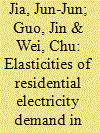

|
|
|
|
|
| Summary/Abstract |
China has implemented the residential increasing-block electricity pricing (IBEP) policy since the second half of 2012, which is considered the most effective economic instrument in improving residential energy efficiency. Price and income elasticity are two fundamental parameters to guide both scholars and policy-makers in assessing whether and to what extend Chinese households respond to the policy. However, it presents the challenge of simultaneous determination of marginal price and electricity consumption; further, it is less examined from an empirical perspective due to the absence of micro-level data. To fill this gap, this study estimates price and income elasticity by establishing two instrumental variables, based on a unique dataset from the Chinese Residential Energy Consumption Survey 2014. Results show that the residential demand for electricity is price inelastic and that electricity is an essential commodity for households in the short run. It also shows great urban-rural disparity and regional heterogeneity of household electricity consumption behavior regarding short-run income elasticity. The estimated parameters of short-run price and income elasticities provide a valuable reference for policy-making regarding both a nationwide uniform and a differential regional perspective.
|
|
|
|
|
|
|
|
|
|
|
|
|
|
|
|
| 3 |
ID:
125526
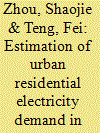

|
|
|
|
|
| Publication |
2013.
|
| Summary/Abstract |
This paper uses annual urban household survey data of Sichuan Province from 2007 to 2009 to estimate the income and price elasticities of residential electricity demand, along with the effects of lifestyle-related variables. The empirical results show that in the urban area of Sichuan province, the residential electricity demand is price- and income-inelastic, with price and income elasticities ranging from -0.35 to -0.50 and from 0.14 to 0.33, respectively. Such lifestyle-related variables as demographic variables, dwelling size and holdings of home appliances, are also important determinants of residential electricity demand, especially the latter. These results are robust to a variety of sensitivity tests. The research findings imply that urban residential electricity demand continues to increase with the growth of income. The empirical results have important policy implications for the Multistep Electricity Price, which been adopted in some cities and is expected to be promoted nationwide through the installation of energy-efficient home appliances.
|
|
|
|
|
|
|
|
|
|
|
|
|
|
|
|
| 4 |
ID:
175899


|
|
|
|
|
| Summary/Abstract |
For the period 1975–2016, this paper examines the determinants of the residential demand for electricity in South Africa including disposable income, electricity prices, food prices as well as the impact of the 2007/08 load-shedding wave and the 2008 electricity price restructuring. Given the high income inequality levels in South Africa, this relationship was investigated at aggregated and disaggregated income levels. Based on an Autoregressive Distributed Lag (ARDL) model, the empirical results indicate long-run cointegration between residential electricity consumption, gross national disposable income, electricity prices and food prices. Disposable income elasticities have a positive sign for the aggregate and all income groups, indicating that as income increases, South African households consume more electricity (normal good). As expected, price elasticities are negative and significant – for both the aggregated and disaggregated models – indicating that electricity prices do influence electricity demand for all South African households. The paper also examines the complementarity or substitutability of food and electricity. At both the aggregated and disaggregated income levels, the results showed that food and electricity are substitute goods for all South African households. However, as expected, the magnitude of this relationship is marginally different for each income group.
|
|
|
|
|
|
|
|
|
|
|
|
|
|
|
|
| 5 |
ID:
119153
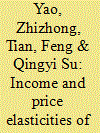

|
|
|
|
|
| Publication |
2013.
|
| Summary/Abstract |
The appearance of new product varieties and improvements in the quality of goods have both played key roles in the rapid growth of China's exports. However, these two important elements have not been formally integrated into the demand equations for China's exports. As we demonstrate in this paper, income elasticity will be underestimated if new varieties of goods and quality improvements are omitted in price index and quantity index calculations, which are necessary for estimating the export demand function. Moreover, the faster new product varieties enter export markets, the greater the underestimation will be. In this paper, we develop an export demand equation that takes into account new product varieties and improvements in quality, and then calculate the demand function for China's exports using the data from 1992 to 2006. According to our estimation, the short-term income elasticity of demand for China's exports is approximately 2.34, and the short-term price elasticity is approximately -0.65. Our estimation predicts an increase in China's export value in the case of an RMB appreciation or export rebate rates reduction in the short term, due to the low price elasticity of China's exports, whose absolute value is less than 1. Our findings are novel and could have significant policy implications.
|
|
|
|
|
|
|
|
|
|
|
|
|
|
|
|
| 6 |
ID:
127773
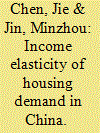

|
|
|
|
|
| Publication |
2014.
|
| Summary/Abstract |
Since 1998, the Chinese housing market has played a fundamental role in driving macroeconomic stability and economic growth. This paper attempts to estimate the income elasticity of housing demand in Shanghai based on a household survey conducted by the National Bureau of Statistics of China in 2007. We utilize a two-stage model, which integrates analysis of both tenure choice and housing demand. Our findings indicate that both permanent and current income has significant influence on tenure choice in Shanghai, and that owner-occupiers' permanent income elasticity of housing demand in Shanghai is between 0.375 and 0.447. Our research also suggests that migrant homeowners have higher permanent income elasticity than Shanghai natives and that most Chinese households are liquidity constrained with regards to obtaining homeownership. We also find that permanent income elasticity increases with age. Finally, the existence of an urban-rural and regional difference is shown.
|
|
|
|
|
|
|
|
|
|
|
|
|
|
|
|
| 7 |
ID:
171368
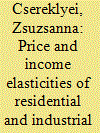

|
|
|
|
|
| Summary/Abstract |
This study examines the short- and long-run price and income elasticities of residential and industrial electricity demand in the European Union between 1996 and 2016. Instrumental variable models using the between estimator, as well as dynamic panel models are employed to present robust estimates, and to assess the impact of different methodologies on the reported elasticities. The long-run price elasticity of residential electricity consumption is estimated between −0.53 and −0.56. These elasticities are more inelastic than that of industrial electricity use, which is reported between −0.75 and −1.01. The choice of different econometric methodologies has only moderate impact on the estimates. While long-run residential income elasticity estimates are moderately inelastic and estimated around 0.61, industrial electricity use tends to be closely tied to income, with elasticities between 0.76 and 1.08. Electricity demand in all sectors is highly price and income inelastic in the short run. Additionally, population density, temperatures, and policy measures also influence sectoral electricity use. The above estimates can aid the design of European energy and environmental policy.
|
|
|
|
|
|
|
|
|
|
|
|
|
|
|
|
| 8 |
ID:
114290


|
|
|
|
|
| Publication |
2012.
|
| Summary/Abstract |
We analyze the rapid growth of Saudi Arabia's domestic oil consumption, a nine-fold increase in 40 years, to nearly 3 million barrels per day, about one-fourth of production. Such rapid growth in consumption - 5.7% annually, which is 37% faster than its income growth of 4.2% - will challenge Saudi Arabia's ability to increase its oil exports, which are relied upon in long-term world oil projections by the International Energy Agency (IEA), US Department of Energy (DOE) and British Petroleum (BP). However, these institutions assume unprecedented slowdowns in Saudi oil consumption - from 5.7% annual growth historically to less than 2% in the future - allowing them to project increases in Saudi oil exports. Using 1971-2010 data, we estimate that the income responsiveness (elasticity) of oil consumption is at least 1.5-using both Ordinary Least Squares regression and Cointegration methods. We believe that continued high growth rates for domestic oil consumption are more likely than the dramatic slowdowns projected by IEA, DOE and BP. This will have major implications for Saudi production and export levels.
|
|
|
|
|
|
|
|
|
|
|
|
|
|
|
|
| 9 |
ID:
125787


|
|
|
|
|
| Publication |
2013.
|
| Summary/Abstract |
OPEC's domestic oil consumption has increased seven-fold in 40 years, to 8.5 million barrels per day (mbd). They consume almost as much oil as China. This constitutes one-fourth of their production. Such rapid growth in consumption (5.1% annually, faster than their income growth of 3.1%) will challenge OPEC's ability to increase their oil exports, which are relied upon in long-term world oil projections by the International Energy Agency (IEA), US Department of Energy (DOE/EIA) and British Petroleum (BP). However, these institutions assume unprecedented slowdowns in OPEC oil consumption - to less than 2% in the future - allowing them to project increases in OPEC oil exports with only modest increases in production. We analyze 1971-2010 data econometrically, with panel co-integration methods. We estimate that the income elasticity of consumption is about 1 for energy and oil. This means that OPEC's energy and oil consumption will grow as rapidly as their income. Hence, continued high growth rates for domestic oil consumption are more likely than the unprecedented slowdowns projected by IEA, DOE/EIA and BP - adding an extra 6 mbd of OPEC consumption in 2030. This will have major implications for OPEC production and export levels, and for world oil prices.
|
|
|
|
|
|
|
|
|
|
|
|
|
|
|
|
| 10 |
ID:
168641


|
|
|
|
|
| Summary/Abstract |
This paper conducts a selective review of various estimates for energy demand responses focused specially upon lower-income industrializing economies rather than richer mature nations. It emphasizes recent trends from empirical studies that have been published after 2000. Emphasis is placed on the five major emerging or transitional economies in Brazil, China, India, Mexico and Russia, although other important nations like Chile and South Korea are also discussed when studies are available. The review focuses attention on the long-run responses to changes in prices and income after capital stock turnover has been completed. The terminology often refers to elasticities, or the percentage change in energy use divided by the percentage change in price (or income), holding constant all other factors that could influence energy-use decisions. Estimates cover petroleum products, natural gas and electricity, although the available studies often ignore coal. They also include the economy-wide impacts (real GDP) to price changes. Most studies have focused upon household and transportation use of liquid fuels; many fewer studies have investigated fuels used by industry or commerce or for electric generation. Based upon the available estimates, price and income elasticities for liquid fuels are generally less than one (unity) for many countries and sectors, except for the long-run income effect for transportation purposes, which can range widely by country between 0.24 and 1.75 while averaging 0.94 for all countries.
|
|
|
|
|
|
|
|
|
|
|
|
|
|
|
|
| 11 |
ID:
176649


|
|
|
|
|
| Summary/Abstract |
Understanding the energy use and choice behaviors in urban China is essential to curb its energy consumption and air pollutant emissions. Current energy consumption estimates for urban households in China rarely account for the effects of building types on energy choice behavior, thus may lead to biased policy implications. In this paper, we estimate the determinants of household energy consumption for different energy choice scenarios through the Seemingly Unrelated Regression (SUR) model, using urban household data. The empirical results show that household use of various energy carriers is driven by household income, fuel price, demographics, building attributes and lifestyles. Results show building types have a significant effect on household energy consumption behaviors. Households living in old houses have less access to clean energy, such as piped gas. Income and price elasticities of energy consumption vary with energy type in each scenario, and there exist certain substitution effects among different types of energy carriers. In particular, inter-fuel substitute elasticities between coal and clean energy are asymmetric. Our study highlights the significance of city planning and infrastructure expansion policies and also offers a better basis for coordinating and designing energy policies in urban China and other developing countries.
|
|
|
|
|
|
|
|
|
|
|
|
|
|
|
|
|
|
|
|
|